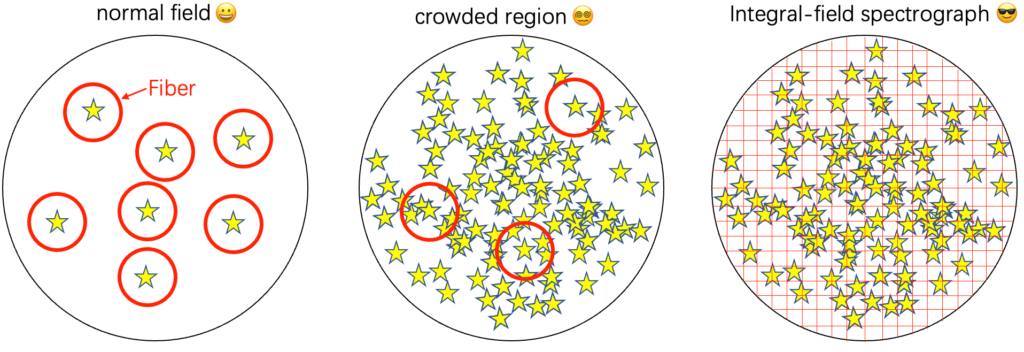Measuring reliable stellar abundances towards crowded regions using MUSE
With the rapid development of stellar spectroscopy in the past decade, many stellar spectroscopic surveys, for example LAMOST, GALAH and APOGEE, combined with the astrometric information of Gaia have played a pivotal role in explaining the chemo-dynamic evolution of the Milky Way. By extracting the elemental abundances and ages of millions of stars from the spectra, astronomers were able to significantly improve their understanding of the chemical and dynamical evolution of the Milky Way.
Although the fibre-fed spectrographs used in the above surveys perform well in general, in the crowded regions they were found to struggle. This is mainly because in crowded regions the angular distance of neighbouring stars can be smaller than the angular size of the fibre. Originally, each fibre just collects the spectrum of one star, but the presence of neighbouring stars will lead to the contamination of the collected light (see Figure 1). As a result, the large spectral surveys have rarely looked at dense regions of the Milky Way, for example globular clusters and the Galactic bulge, which play a crucial role in the evolution of the Galaxy.

To obtain stellar spectra in crowded fields, the integral-field spectrograph (IFS) turns out to be very useful. Unlike the fibre-fed spectrograph, the IFS (e.g., MUSE) has a spectrum for every pixel (so-called spaxel), so it is possible to get clean stellar spectra in crowded regions even though the stars are very close to each other (PampelMuse code by Kamann, Wisotzki & Roth 2013). However, until now there has not been a robust and efficient method to extract stellar abundances from spectra extracted from MUSE.

Therefore, we developed a novel method to measure the abundances in the MUSE stellar spectra (Wang et al. 2022). We use a data driven neural network based model for LAMOST spectra, DD-Payne by Xiang et al. (2019), which was trained on labels from APOGEE/GALAH. For the current MUSE observations, we are able to determine stellar parameters with precision better than 75K in T_eff, 0.15 dex in log g, and 0.1 dex in abundances of [Fe/H], [Mg/Fe], [Si/Fe], [Ti/Fe], [C/Fe], [Ni/Fe], and [Cr/Fe] over a parameter range of 3800 < T_eff < 7000 K, −1.5 < [Fe/H] < 0.5 dex (see Figure 2 above). We also analysed the [α/Fe]-[Fe/H] distributions of stars in nine MUSE fields towards the Galactic bulge (see Figure 3 below). The distribution is consistent with that obtained from high spectral resolution APOGEE data by Ting et al. (2019).

In addition to studying dense star fields such as globular clusters or the Milky Way bulge, MUSE has also been used to target about 15,000 other fields across the southern sky since it was first commissioned in 2014. These other fields typically have a few Milky Way stars in them. Our method will enable the automated determination of stellar parameters for all stars in these fields. Given that most elements have strong absorption features for wavelength less than 4500 Angstroms, the upcoming BlueMUSE and MAVIS instruments on the VLT will be a huge boon for studying crowded regions. They will enable high precision (better than 0.1 dex) abundance measurements of a whole new range of elements, e.g, N, Al, O, Na, and Co. Crucially, s-process elements like Y and Ba that provide key age diagnostics for stellar targets will also be measured.
Article Written by Zixian (Purmortal) Wang
Republished by Astronomy Australia Ltd.

